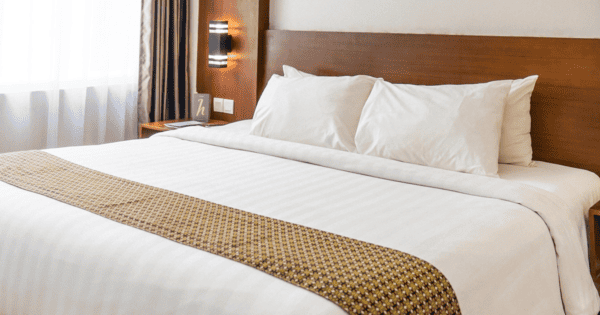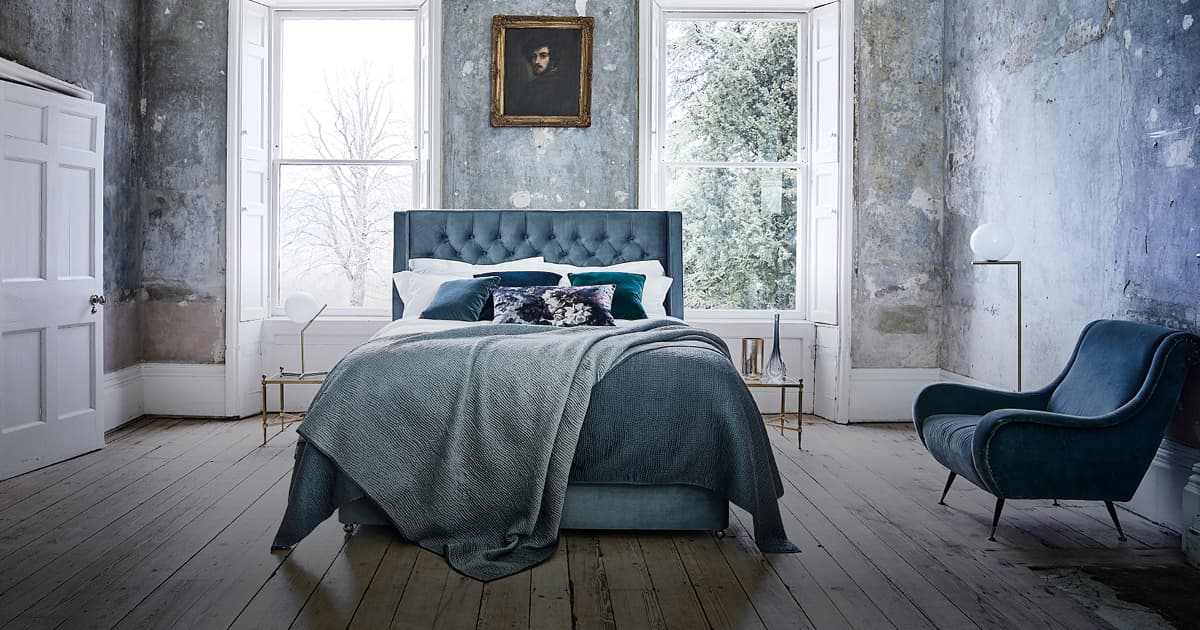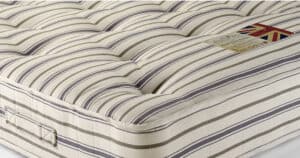
We all know how to throw a duvet on our bed and chuck the closest bedding on. But did you know that the way you dress your bed can significantly impact its appearance? Dressing your bed in the correct way can transform the ambience of your bedroom.
In this guide, we’ll offer insights on the basics of dressing a bed, as well as how to add layers for comfort, pillows and blankets, and the finishing touches.
How to Dress a Bed: Step-by-Step Instructions
Step 1: The Basics
When you’re dressing a bed, it’s vital that you start with the essentials. This foundational step includes various hotel-quality supplies such as mattress pads or protectors, fitted sheets and flat sheets.
The mattress pad or protector forms the first layer. This handy addition keeps your mattress dust, stain, and wear-free! By choosing a good-quality mattress protector, you can also add a layer of comfort.
Next is the fitted sheet. You need to pull this tight over your mattress so there are no wrinkles in sight. It’s important to choose a fitted sheet that fits your mattress well; otherwise, you’ll likely have sagging corners and wrinkles. Fitted sheets made from breathable fabrics like cotton are the best choices as they keep you warm on the cold wintry nights but cool in the hot summer.
The final stage of the basics is the flat sheet – you place this on top of your fitted sheet. Ensure you place it on your bed with the finished or printed side down. You’ll notice that, if you have done this correctly, you’ll be able to see the design when you fold it over.
Step 2: The Comfort Layer
You’ve added the basics to your bed. Next on the agenda is adding comfort. For this, you’ll need a blanket or coverlet, a duvet or comforter, and a quilt or bedspread (if you get cold at night).
A blanket or coverlet goes on as the first layer of comfort. You can choose whether you want a lightweight blanket or a heavier one. If you tend to get warm at night, you’re better off going for a lighter one. To give your bed a truly polished look, fold around 6 inches of the top of the flat sheet and blanket together.
Then, for the duvet or comforter. Ensure you centre this on the bed, letting it overhang each side of the bed slightly. It’s important that each side is equal, as otherwise, this can look messy. When choosing a duvet or comforter, opt for one with a down or alternative down filling, as these are far more breathable.
After this, you may choose to add a quilt or bedspread – this element is optional, as there’s no point in loading yourself up with a quilt or bedspread if you’re already like a radiator at night!
Step 3: Add Pillows and Cushions
You can’t have a bed without pillows or cushions! Well, not a comfy one, anyway. Sleeping pillows are a fundamental element of dressing a bed, but you can also add shams, decorative pillows, and throw pillows if your heart desires!
In terms of sleeping pillows, it’s vital that you have as many as is comfortable for you. You may choose to have one or two for a single bed, two or four for a double bed, and four for a king-size bed.
Then, as you’re not likely to sleep on the exposed pillow, it’s time to add shams. We often buy these as a set with a duvet cover, so they match.
If you feel like you need a little more pizzazz after you’re done adding the shams, try decorative pillows and throw pillows. Decorative pillows tend to be quite large, with a design that complements your chosen bedding. You can have a mixture of small and large decorative pillows, but ensure you start with the larger ones at the back and layer down so the smallest are at the front. Then, for the ultimate cosiness, add some smaller throw pillows.
Step 4: The Finishing Touches
It’s time for the finishing touches! This is the moment you have been waiting for – you’ll finally get to see what your fully dressed bed looks like. The finishing touches include two key components: a bed runner and a throw blanket.
Place a bed runner that complements the rest of your bedding at the foot of your bed. While you want to choose a runner with a complementary colour scheme, don’t be afraid to go bold here and add a splash of colour – this will help it really stand out.
Finally, add your throw blanket. Casually drape this at the end of your bed – it’ll make your bed look super cosy and inviting.
Top Tips When Dressing a Bed
Here are some top tips to keep in mind when you start the process of dressing your bed:
- Consider the thread count. Many people mistakenly think that a higher thread count immediately indicates better quality. Bear in mind that a 1000 thread count sheet made from average-quality cotton won’t feel anywhere near as soft as a 300 – 500 thread count sheet made from quality cotton.
- Don’t forget about allergies. If you have allergies, ensure you choose bedding made from hypoallergenic materials. This should be clearly visible on the packaging – you’ll usually find it on down-alternative fillings for pillows and duvets. If it isn’t clearly stated on the packaging, don’t risk it!
- Prioritise natural materials. Natural materials will always, always make better bedding than synthetic materials. Opt for natural materials like linen or cotton, as these are more breathable, meaning you shouldn’t get swelteringly hot or freezing cold.
Final Verdict on How to Dress a Bed
Dressing a bed properly has four key steps. Once you get these right, you’ll have the winning combination of comfort, style, and warmth. But remember – if you’re shopping for bedding, keep an eye on the thread count, and ensure you choose items made from natural materials or hypoallergenic ones if you suffer from allergies.



